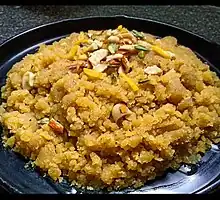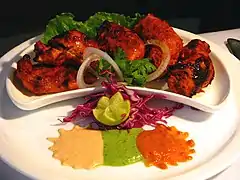 Moong Dal Lapsi is commonly prepared during Diwali festival. | |
| Course | Dessert |
|---|---|
| Place of origin | India |
| Region or state | Uttar Pradesh, Bihar, Haryana, Rajasthan, Gujarat, Madhya Pradesh, Maharashtra[1] |
| Main ingredients | Grain flour[2] or Broken wheat, milk, ghee, sugar or jaggery, nuts, raisins and other dried fruits |
Laapsi or lapsi is an Indian sweet dish made using grain flour or broken wheat and ghee, along with milk, nuts, raisins and other dried fruits. Lapsi is commonly prepared during Hindu ceremonies and is served as a religious offering to Devtas.[1] Lapsi forms an integral part of North Indian cuisine and has many variants.
Etymology
The name Lapsi (लप्सी) or Laapsi (लापसी) is derived from Sanskrit word Lapsikā (लप्सिका).[3]
History
References to Lapsi are present in Ancient and Medieval Sanskrit literature, particularly Ayurvedic literature, Pākaśāstra texts (Hindu culinary texts) and Puranas (Hindu religious scriptures). Skanda Purana mentions Lapsika as a Naivedhya for Puja (Hindu ritual worship).[4] Lapsi finds mention in an Ayurvedic text named Bhāvaprakāśa nighaṇṭu.[5] The recipe of Lapsi is vividly described in Bhojanakutūhala, one of the important Pākaśāstra texts.[6] The recipe of Lapsi in Bhojanakutūhala uses samita (refined wheat flour) as the main ingredient.[5] Bhakt Surdas, a renowned Hindu saint of Bhakti tradition makes a mention of Lapsi in his Braj poetry.
लुचुई ललित लापसी सोहै । स्वाद सुबास सहज मन मोहै ।।
Luchuī Lalita Lāpasī Sohai, Svāda Subāsa Sahaja Mana Mohai— Sūradāsa [7]
Variants
There are different types of Lapsi depending on the main ingredient:
- Aate Ki Lapsi (Whole wheat flour Lapsi)
- Suji or Rava ki Lapsi[8] (Semolina Lapsi)
- Dalia or Fada ki Lapsi (Broken wheat Lapsi)
- Besan Ki Lapsi[9] or Chana dal Lapsi (Gram flour or Bengal gram lentil Lapsi)
- Moong dal Lapsi (Mung bean Lapsi)
- Singhare Ki Lapsi[10] (Water chestnut Lapsi)
- Badam ki Lapsi (Almond Lapsi)
Cultural Uses
Different variants of Lapsi are prepared in Hindu households during different festive occasions and religious ceremonies. The combo of 'Lapsi & Puri' or 'Lapsi & Suhari' is prepared along with Kala chana(black Bengal gram)[11], on Durga Ashtami festival. Usually, Suji Ki Lapsi is prepared for Durga Ashtami & other Mangalik karyas (auspicious works).[12]
Singhare ki Lapsi is usually prepared as a Phalahaari diet for Vrat.[10] Moong Dal Lapsi is a common dessert during Diwali festival. Besan Lapsi & Badam ki Lapsi is prepared as a winter dish.[9]
Dalia or Fada ki Lapsi is a popular variant prevalent in the states of Rajasthan, Gujarat and Maharashtra.[13]
References
- 1 2 "Cuisine of Haryana". RasoiTime. 10 August 2018. Retrieved 15 June 2022.
- ↑ Grierson, Sir George Abraham (1885). Bihār Peasant Life: Being a Discursive Catalogue of the Surroundings of the People of that Province, with Many Illustrations from Photographs Taken by the Author. Bengal secretariat Press.
- ↑ Apte, Vaman Shivaram (1998). The Practical Sanskrit-English Dictionary. Motilal Bnarsidass Publishe. ISBN 978-81-208-1568-1.
- ↑ Studies in Indian Epigraphy. Epigraphical Society of India by Geetha Book House. 2005.
- 1 2 www.wisdomlib.org (14 February 2019). "Lapsika, Lapsikā: 5 definitions". www.wisdomlib.org. Retrieved 15 June 2022.
- ↑ Sreeja, K.N. (2016). Dietetics and culinary art in ancient and medieval India A study with special reference to bhojanakutuhala (Thesis). hdl:10603/145416 – via Shodhganga.
- ↑ बच्चन (1998). 'दशद्वार' से 'सोपान' तक (in Hindi). Rajpal & Sons. ISBN 978-81-7028-117-7.
- ↑ Lokrajya. Directorate-General of Information and Public Relations. 1976.
- 1 2 "Lappi recipe". www.tarladalal.com. Retrieved 18 June 2022.
- 1 2 Sarma, Inguva Karthikeya (2006). Mahāsenasiri: Riches of Indian Archaeological & Cultural Studies : a Felicitation Volume in Honour of Dr. I. K. Sarma. Sharada Publishing Company. ISBN 978-81-88934-38-6.
- ↑ Singh, Dr Rajeev (12 September 2022). "Black Chana: Uses, Benefits, Side Effects By Dr. Rajeev Singh". PharmEasy Blog. Retrieved 13 December 2023.
- ↑ Registrar, India Office of the (1962). Census of India, 1961. Manager of Publications.
- ↑ "Fada ni Lapsi". gujrattourism. Retrieved 19 June 2022.


